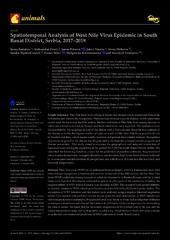Приказ основних података о документу
Spatiotemporal Analysis of West Nile Virus Epidemic in South Banat District, Serbia, 2017–2019
| dc.creator | Radojičić, Sonja | |
| dc.creator | Živulj, Aleksandar | |
| dc.creator | Petrovic, Tamas | |
| dc.creator | Nišavić, Jakov | |
| dc.creator | Milićević, Vesna | |
| dc.creator | Sipetic-Grujicic, Sandra | |
| dc.creator | Mišić, Dusan | |
| dc.creator | Korzeniowska, Malgorzata | |
| dc.creator | Stanojević, Slavoljub | |
| dc.date.accessioned | 2021-12-16T08:51:09Z | |
| dc.date.available | 2021-12-16T08:51:09Z | |
| dc.date.issued | 2021 | |
| dc.identifier.issn | 2076-2615 | |
| dc.identifier.uri | https://vet-erinar.vet.bg.ac.rs/handle/123456789/2298 | |
| dc.description.abstract | West Nile virus (WNV) is an arthropod-born pathogen, which is transmitted from wild birds through mosquitoes to humans and animals. At the end of the 20th century, the first West Nile fever (WNF) outbreaks among humans in urban environments in Eastern Europe and the United States were reported. The disease continued to spread to other parts of the continents. In Serbia, the largest number of WNV-infected people was recorded in 2018. This research used spatial statistics to identify clusters of WNV infection in humans and animals in South Banat County, Serbia. The occurrence of WNV infection and risk factors were analyzed using a negative binomial regression model. Our research indicated that climatic factors were the main determinant of WNV distribution and were predictors of endemicity. Precipitation and water levels of rivers had an important influence on mosquito abundance and affected the habitats of wild birds, which are important for maintaining the virus in nature. We found that the maximum temperature of the warmest part of the year and the annual temperature range; and hydrographic variables, e.g., the presence of rivers and water streams were the best environmental predictors of WNF outbreaks in South Banat County. | |
| dc.language | en | |
| dc.publisher | MDPI | |
| dc.relation | info:eu-repo/grantAgreement/MESTD/inst-2020/200031/RS// | |
| dc.rights | openAccess | |
| dc.rights.uri | https://creativecommons.org/licenses/by/4.0/ | |
| dc.source | Animals | |
| dc.subject | GIS | |
| dc.subject | mosquitoes | |
| dc.subject | sentinel animals | |
| dc.subject | spatial analysis | |
| dc.subject | West Nile virus | |
| dc.title | Spatiotemporal Analysis of West Nile Virus Epidemic in South Banat District, Serbia, 2017–2019 | |
| dc.type | article | en |
| dc.rights.license | BY | |
| dc.citation.volume | 11 | |
| dc.citation.issue | 10 | |
| dc.citation.spage | 2951 | |
| dc.citation.rank | aM21 | |
| dc.identifier.wos | 000716730800001 | |
| dc.identifier.doi | 10.3390/ani11102951 | |
| dc.identifier.scopus | 2-s2.0-85116909119 | |
| dc.identifier.fulltext | http://veterinar.vet.bg.ac.rs/bitstream/id/6343/animals-11-02951-v2.pdf | |
| dc.type.version | publishedVersion |

